How Japan’s global image morphed from military empire to eccentric pop-culture superpower
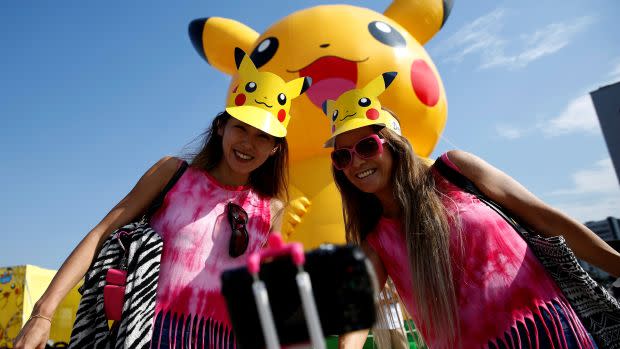
In 1965, the American TV show Gilligan’s Island aired an episode titled “So Sorry, My Island Now.” It follows the show’s castaways as they encounter a Japanese soldier, or a racist caricature of one anyway, who doesn’t realize World War II has ended. As is often the case with stereotypes, it says more about how Americans viewed Japan at the time than about Japan itself: In America’s eyes, it was still the militaristic aggressor, the country that colonized Korea, invaded China, and bombed Pearl Harbor, drawing the US into war—and deserved to be mocked for being on the losing side of that conflict.
About two decades later, the 1986 movie Gung Ho directed by Ron Howard reflected a very different view of Japan. It’s about an American auto plant taken over by a Japanese company and the culture clash that erupts over their differing views of labor. The Japanese characters are practically automatons, obsessed with efficiency and order, reflecting the prevailing picture of Japan as a mechanized producer of cars and electronics.
Jump ahead once more to the early 2000s, and you’ll find yet another dominant image of Japan in the US—except this time Japan produced it. Spirited Away was director Hayao Miyazaki’s gorgeously animated story of a young girl who wanders through a world of witches and spirits after her parents become pigs. It became the highest-grossing movie in Japan’s history and in the US won the 2003 Oscar for best animated feature.
By then American audiences had already come to think of Japan as its own sort of fantasyland, the creator of manga comics, Nintendo, and the adorable force known as Hello Kitty. In its review of Spirited Away, the New York Times pointed out that while Disney distributed the movie, it never could have created it. Its atmosphere was one only anime—animation generally based on manga—could deliver.
In just a few decades, Japan’s global image has changed radically, especially in the West. The shifts have been so drastic it can be hard to recognize the same country in these different visions of it. Particularly in America, which has had a close and complex relationship with Japan since World War II, this image has evolved from fearsome enemy to producer of cheap cars and gadgets to, finally, whimsical creative fantasy factory.
This last step shows just how potent pop culture can be in shaping national identity on the global stage. Today the country’s exports of TV, movies, and toys stand as one of the world’s premier examples of soft power, or the ability to influence and attract international cooperation through persuasive means, such as culture, rather than by direct payment or force. They’ve even become a major source of national pride.
But as fast as Japan’s growth into a pop-cultural giant seems, it took time and the right mix of conditions—economic, certainly, and perhaps social as well—to invent Japan’s global image. Its status as Asia’s dominant cultural exporter has now come into question, too, as Korea emerges as a new pop powerhouse.
The emergence of Japan as a fantasyland
Prior to World War II, Americans had some sense of Japanese culture, but it centered on rarefied practices such as calligraphy, Zen Buddhism, and sumo. It was ancient, beautiful, and rigid. But in the years after the war, different products would begin to shape a new image of Japan beyond its borders.
In film there was Akira Kurosawa’s Rashomon and its win of the top prize at the 1951 Venice Film Festival. “That really caught the world by surprise,” says Hiroshi Kitamura, an associate professor of history at William & Mary and author of Screening Enlightenment: Hollywood and the Cultural Reconstruction of Defeated Japan. “It led to the distribution of the film in theaters, usually art-house theaters in different parts of the world, including the United States. That opened the eyes of many viewers, not just in the US but in the West, toward Japan.”
Another Japanese movie would prove popular with American audiences too, though it came from a different part of Japanese culture. When Gojira, or Godzilla as it was known in the US, stomped onto US shores in 1956, in a recut meant to appeal to US viewers, it offered them an introduction to Japanese monsters—in this case one that would reappear in subsequent movies and countless reruns on American television.
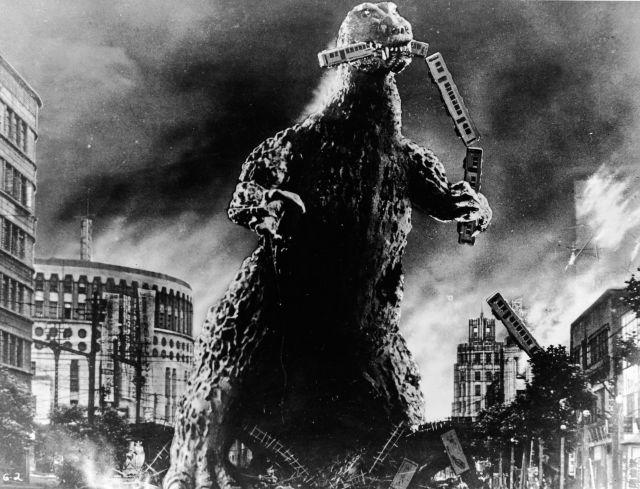
King of the monsters.
It kicked off a slow trickle of Japanese pop culture into the US, followed next in the mid-1960s, when Astro Boy became the first anime to appear on American screens. Soon other Japanese cartoons, such as Speed Racer and Star Blazers, followed it into the US market.
And then perhaps the first big anime hit arrived in the US: Battle of the Planets, known in Japan as Gatchaman. As of 1979, the show was running on 100 network affiliates during after-school hours. “For many American teens and young adults, this would be their first taste of Japanese pop,” wrote author Roland Kelts in his 2006 book, Japanamerica: How Japanese Pop Culture Has Invaded the US. It showed Americans another aspect of Japanese culture that many were unfamiliar with, even though Japan’s artistic and storytelling traditions of course dated back hundreds of years. The Tale of Genji, often called the world’s first novel, is from the 11th century.
But there was much more to Japanese culture than US audiences generally knew, and had older roots than they realized. Manga’s origins could be said to reach back to the early 19th century and the artist Katsushika Hokusai, who started to publish his “Hokusai manga” picture books in 1814. (Manga translates roughly to “whimsical drawings.”) They’re not quite a direct ancestor, since he filled his books with varied sketches and didn’t follow one storyline. But he helped establish a manga tradition, and became one of the first Japanese artists to achieve popularity in the West, specifically among French painters during a craze for Japanese design called Japonisme that swept Europe in the decades after the US Navy steamed into Edo Bay—now Tokyo Bay—in 1853 and forced Japan to open its ports. The Great Wave is probably Hokusai’s best-known piece.
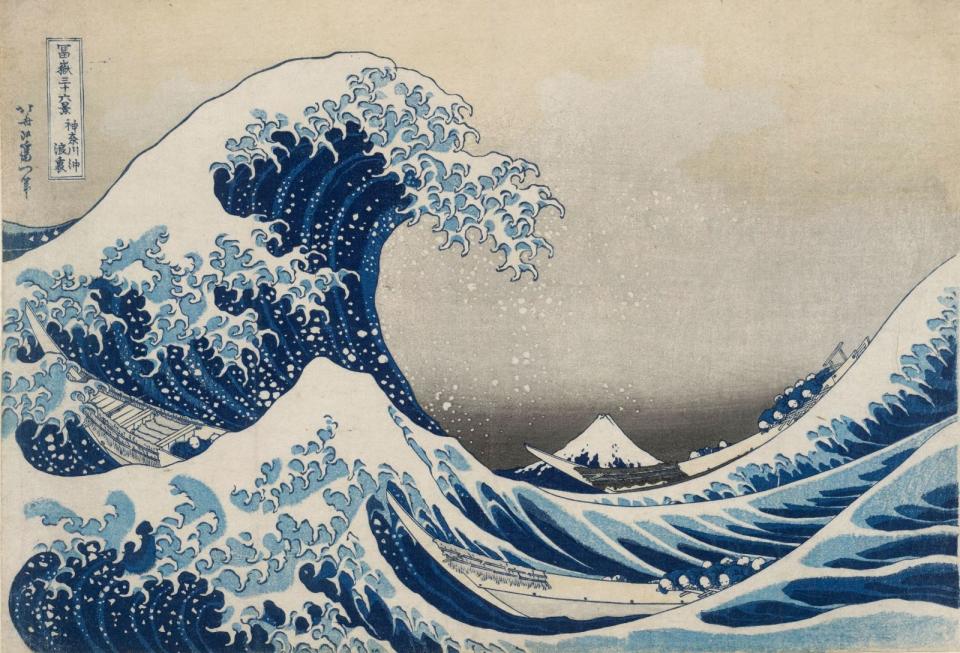
Hokusai’s “The Great Wave.”
The modern form of manga took shape in the 1950s and 1960s, when publishers started printing weekly manga magazines similar to graphic novels. One of its most influential figures is Osamu Tezuka, who created the Astro Boy manga, known in Japan as “Mighty Atom.” As early as the 1980s manga was starting to build a readership outside Japan. It has since found fans everywhere with the explosion of Japanese culture, and the fantastical stories and characters that populate it.
There are various theories about why Japan has proved so adept at producing them. Matt Alt, cofounder of translation and consulting service AltJapan and author of multiple books about Japan, including the forthcoming Pure Invention, which traces the country’s pop-cultural ascent, believes Japan possesses cultural traits which make it adept at conjuring up characters, or at least seeing them where others might not. “Unlike the West, Japan has this long polytheistic, animistic tradition,” he says, pointing to the Shinto religion and its 8 million gods. “It gave rise to this culture of personification of all sorts of things.”
During the Edo period from about 1603 to 1867, those personifications resulted in monster-like characters dubbed yokai, which emerged first in local tales before becoming part of Japanese folklore. They could appear as anything from a sentient broom or shoe to a fully invented creature. Alt argues all these elements laid the groundwork for the present.
“That kind of ability to tell stories and to create characters from almost anything fueled the rise of things like Hello Kitty or Mario or the Pokémon or Dragonball that turned into these massive franchises,” he says. “Japan has always had this ability to pair really compelling characters visually with really compelling stories, and that’s really what popular culture and entertainment is about.” There’s also Japan’s shokunin, or artisan, spirit, which promotes devotion to a craft, arguably making Japanese creators more likely to lavish extra attention on the fine details that elevate work from good to great.
The artist Takashi Murakami has provided a different explanation. He’s described Japan as the world’s first post-apocalyptic society—the product of two atomic explosions that inflicted deep trauma in the national psyche. Japanese creators, he believed, turned to manga, anime, and other forms of pop culture to grapple with and express their anxieties.
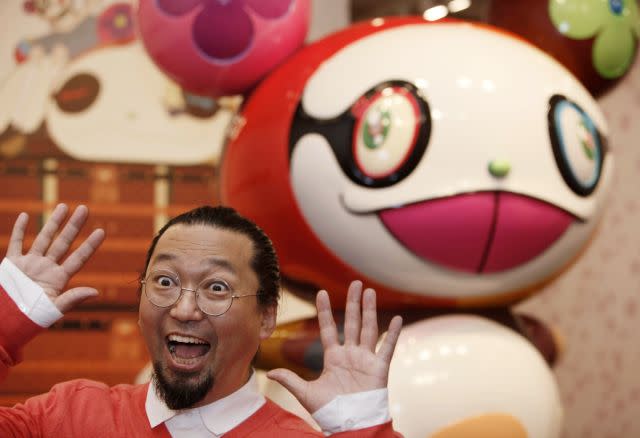
Post-apocalyptic.
Whether or not the apocalyptic events of World War II were the crucible for modern Japanese pop culture, the conflict certainly prompted a reinvention of the country. After the war, the US occupied Japan and instituted a number of political and social reforms, including creating a new constitution and policies meant to make Japan more democratic. Japanese schools began to instruct students in democratic values, and when the Korean War started in 1950, UN forces used Japan as their primary supply base, refashioning the country as an ally of the West.
Though World War II devastated Japan, its economic recovery afterward was startlingly fast. To catch up with other industrialized nations, the country mobilized to rebuild and expand its manufacturing base. It found its footing making cars and electronics, which it churned out for export around the globe. When it hosted the 1964 Olympics in Tokyo, it used the opportunity to reintroduce itself to the world as peaceful and prosperous.
Another shift was occurring too. Before the war, Japan’s consumer-goods exports were notoriously shoddy and often regarded abroad as cheap rip-offs of other companies’ designs. But after the war, its manufacturers steadily morphed into paradigms of quality and productivity. By the 1970s, companies such as Sony, Matsushita (now Panasonic), Mitsubishi, and Toyota were becoming worldwide leaders in their industries. A generation of Western executives began looking to Japan for management techniques, helping give rise to the image of Japan as a hyper-efficient business culture. In the US and Europe, the idea of Japan as a military enemy had mostly subsided.
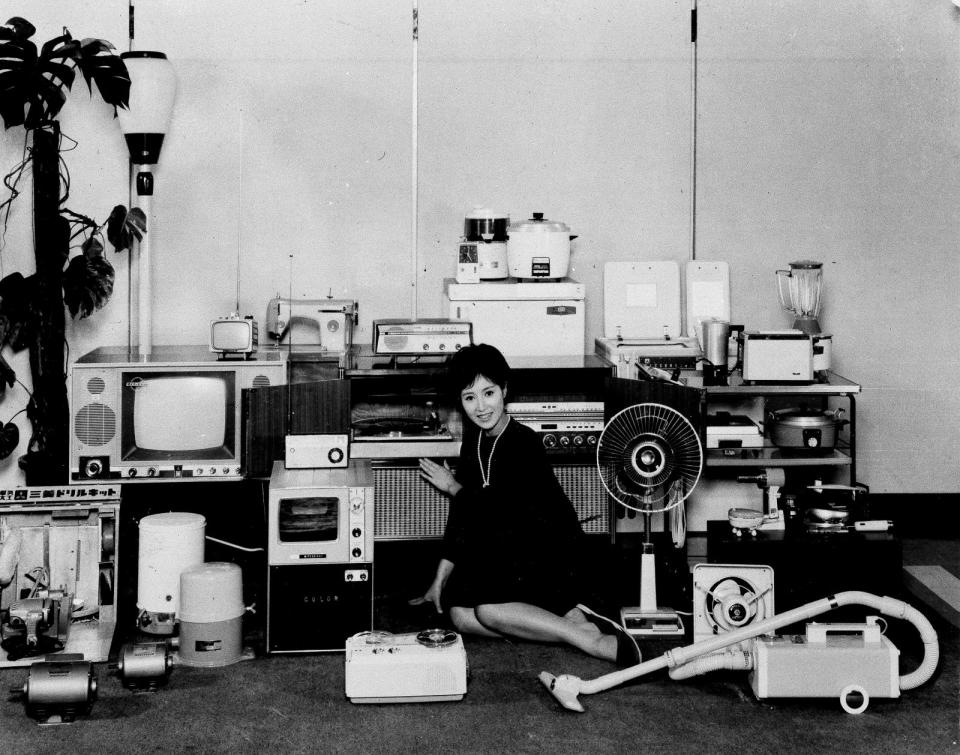
The works of Mitsubishi Electric Co. in 1964.
Then, in 1979—the same year Battle of the Planets hit US airwaves—Sony released the Walkman. It was the first personal cassette player, allowing the average consumer to listen to music whenever and wherever desired. Japan wasn’t just making top-notch consumer electronics, it was reimagining them.
Nintendo power
These successes helped reshape ideas about Japan outside the country, and led to a major game-changer: Nintendo
“If you really want to talk about the pivotal moment when Japanese fantasies started truly inflecting those of young people in the West, I think that moment comes with Nintendo Entertainment System in the 1980s,” Alt says.
Nintendo’s US debut came in 1985, just after the crash of the US’s homegrown video-game market once led by Atari. Nintendo had started as a small maker of playing cards in Kyoto nearly a century before, but after that business declined in the 20th century, it dabbled in different ventures, including electronic toys. Its game console was a mega-hit. Within three years of the release, the New York Times reported the company had sold some 10 million systems in the US.
“It’s a mania,” Rick Anguilla, editor of the industry journal Toy and Business World, told the Times. “The kids of America are saying ‘This is great, we’ve got to have one.’ For boys in this country between the ages of eight and 15, not having a Nintendo is like not having a baseball bat.”
Nintendo’s centerpiece, the game Super Mario Bros., was the invention of Shigeru Miyamoto, who also created the Legend of Zelda series, Donkey Kong, and more. It brought kids into an immersive arena like none they’d ever experienced, where a dinky plumber traversed the Mushroom Kingdom stomping turtles and other baddies in his quest to save a princess. It was weird and inventive and established Japan as a builder of worlds as much as electronics. The company would keep producing successful games, and in 1989 released the handheld Game Boy. That year, another Japanese gaming company, Sega, launched its first console in the US, giving Nintendo its first real competition and delivering another Japanese hit to American kids.
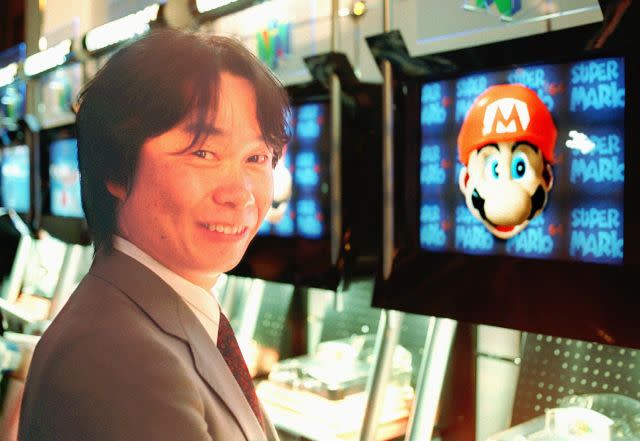
Miyamoto and Mario in 1996.
Japan, it turned out, had a talent for keeping kids affixed to TV screens. The ideas it produced were different, which was integral to its appeal. When Margaret Loesch, who was the head of Fox Children’s Network in the US, wanted some kids programming other than the typical cartoons filling up the air, she looked to Japan. “As a child I loved the old Godzilla movies,” she told the Los Angeles Times in 1993. “I couldn’t get enough of them. It didn’t matter if I could see the wires and the seams in the costumes and the lips moving when the words didn’t—they were so fanciful and imaginative.”
She found a live-action superhero series in the style of old Japanese monster movies, called Mighty Morphin Power Rangers. The show—a co-production of US-based Saban Entertainment and Japan’s Toei Co.—was part of a combo of 1990s hits that helped cement Japan’s new reputation. The other was a Nintendo product, at least partly. Pokémon, developed and distributed by a trio of companies that included Nintendo, spawned a television show, card game, movie, and of course video games. Through the mid- and late-1990s in the US, it had the effect of promoting Japan as fantasy machine while kindling a desire for more.
“Each of the major studio bosses that I have visited has sometimes grudgingly admitted that Pokemon was the crowbar that levered Japanese animation back into the United States as a powerful commercial force,” Kelts wrote in Japanamerica. “The vanguard Japanese cartoons of the 1970s had softened the market somewhat, but Pokemon was the driving force that tore it open.”
Crucially, there was another force at work behind the ascent of these cultural products: money.
“I have this somewhat contrarian view that the success of Japanese culture doesn’t have all that much to do with Japanese culture,” says Nick Kapur, an assistant professor of Japanese history at Rutgers University-Camden and author of Japan at the Crossroads. “It’s the wealth effect.”
In the years following World War II, Japan’s economy grew so quickly that in 1968 it unseated West Germany’s as second-largest in the world. (Today it’s been knocked down to third-largest after China overtook it in 2011.) Japan’s per-capita wealth surged, and spiked even higher during the “bubble economy” from the mid-1980s to the early 1990s. In cities such as Paris and Honolulu, luxury shops overflowed with Japanese customers. From the US, Japan started to look like a threat to its own economic dominance, provoking criticisms from figures such as Donald Trump and underpinning fears of Japanese takeover as embodied in Michael Crichton’s novel, Rising Sun.
Japan’s economic success played a lead role in its culture industries. Flush with disposable income, Japanese consumers spent freely on everything from entertainment to clothing, fueling the growth of those industries. Fashion sales, for example, hit a peak in Japan in 1991 at 19.9 trillion yen (about $148 billion at the time, which would be $280 billion today), according to W. David Marx’s Ametora: How Japan Saved American Style, which chronicles how Japanese designers have reinterpreted American style to global success.
And then at the end of 1991, inflated to its limit by a frenzy of speculation that drove market and real-estate prices to stratospheric highs, the bubble burst, ushering in a so-called lost decade of economic stagnation. Even so, the country’s culture industries kept humming. The 1990s, in fact, were a particularly fertile period. In fashion, Tokyo’s Harajuku scene flourished along with the clothing companies that emerged from it, such as A Bathing Ape and Undercover. In art, Murakami began gaining international attention. The anime classic Neon Genesis Evangelion first aired in Japan in 1995. Pokémon launched in 1996.
Marx, the chronicler of Japanese menswear, points out in an interview that after the bubble popped consumer spending still climbed for a couple years longer. “Japanese culture exploded in the ’90s because it was rich and all sorts of money was going into consumer culture,” he says.
Even in 2002, when Rebecca Mead wrote about fashion in Harajuku and the phenomenon of kawaii, or cute, for the New Yorker, she remarked that “you wouldn’t know that the country is in recession from the way young people spend money.”
Though sluggish growth has persisted, Japan remains a wealthy society. Kapur says the volume of products it has produced over the years has been so high that it was bound to have a number of successes. It produces a lot of bad pop culture too, he says.
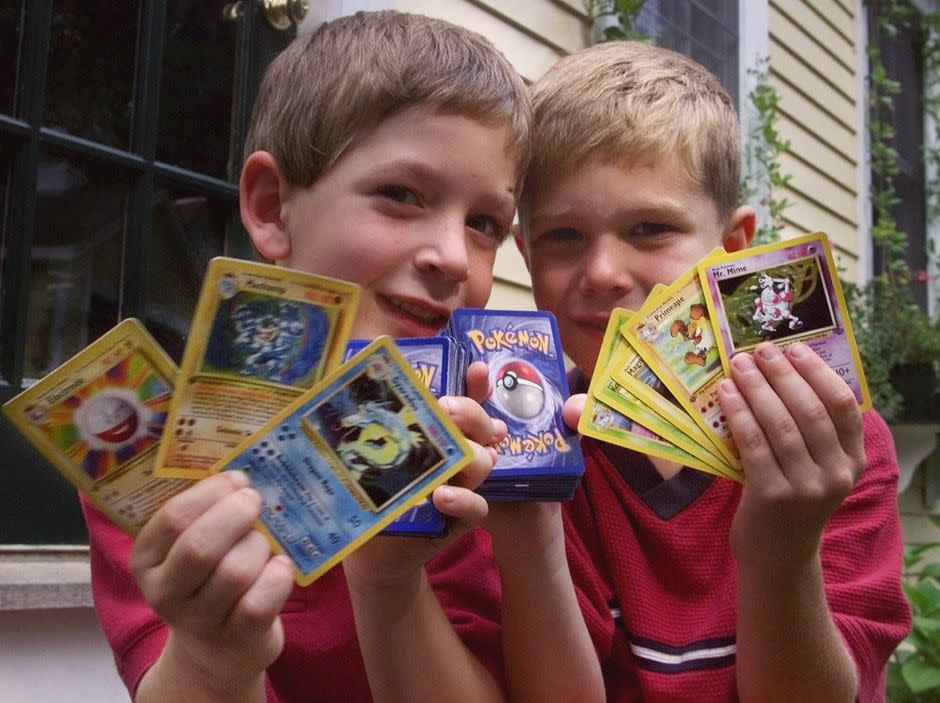
Two Massachusetts boys show off their Pokémon cards in 1999.
Japanese animation, or anime, is now one of Japan’s most powerful cultural exports and a leading force in shaping Japan’s image outside its borders. Series such as Dragon Ball Z and Sailor Moon helped it catch hold in the 1990s, and today it’s popular enough to be on the frontlines of the battle between streaming services. Once hard-to-find shows such as Neon Genesis Evangelion are now available to Netflix viewers.
Manga has a broad audience outside Japan. In 2019, about 6.8 million copies of different manga titles sold in the US, a 26% rise over the previous year, according to research firm NPD Group. Titles such as My Hero Academia made it one of the fastest-growing forms of comic book and graphic fiction in the country.
Japan has had notable successes in other cultural arenas. The fashion industry recognized it as a creative leader as early as 1981, after Yohji Yamamoto and Comme des Garçons staged their first shows in Paris. In 2002, Amy Spindler, then style editor of the New York Times, declared Tokyo—not Paris, Milan, or New York—the international capital of fashion. By the time Spirited Away appeared in the US, Americans had already come to think of Japan as producer of the wacky, cutesy, and cool, and to regard Tokyo as a global cultural hotspot.
Curiously, though, everyone I spoke to agreed Japanese companies, with the exception of Nintendo, are typically not very good at exporting their products. There are a few instances of Japanese companies actively trying to attract Western audiences and tailoring their products to make them more appealing. Godzilla was recut with a white character. Anime series in the 1960s and 1970s were redubbed in English and their stories changed.
But most of the time, when audiences outside Japan have become fans of a particular manga, anime, clothing line, or whatever else, it’s because they’ve stumbled on it or heard about it through word-of-mouth. There are efforts underway to change that paradigm.
Spreading the gospel of cool Japan
In 2002, Douglas McCray, a contributing writer at the magazine Foreign Policy, wrote an article titled “Japan’s Gross National Cool.” It took stock of Japan’s outsized cultural sway around the world. “Instead of collapsing beneath its political and economic misfortunes, Japan’s global cultural influence has only grown,” he wrote. “In fact, from pop music to consumer electronics, architecture to fashion, and food to art, Japan has far greater cultural influence now than it did in the 1980s, when it was an economic superpower.”
Pop or otherwise, culture is integral to Japan’s soft power, as McCray pointed out. Different measures, such as a recent one by Brand Finance, a brand-valuation consultancy, rank Japan among the top countries in the world in soft power.
Prompted at least in part by McCray’s article, the government took a new interest in promoting Japanese culture, and not just the traditional forms such as Noh drama, tea ceremony, and ikebana (flower arranging), but new stuff too. The effort to sell culture abroad is called “Cool Japan.” In 2013, it launched a fund to assist the spread of Japanese culture abroad.
Despite the efforts, and money, it hasn’t gone well. The projects have racked up losses with little to show in return. “The Japanese government, in the last 10 years or so, has finally been waking up and saying, ‘Oh wow we are this global pop culture powerhouse,'” Kapur says. “But even then, the Japanese government, aside from empty talking points, doesn’t really know what they should be doing to spread Japanese pop culture even more. They haven’t, for instance, changed certain licensing laws that would make it easier to spread things overseas.”
Even so, the spread of Japanese culture doesn’t seem to be slowing, thanks at least in part to companies that still see opportunities, and facilitators such as Japan’s Tetsu Fujimura. Fujimura is an executive producer whose company, Filosophia, has helped bring Japanese titles such as Ghost in the Shell and Cowboy Bebop to American audiences. He refers to them simply as IP, or intellectual property. “My function is like a bridge between Japanese IP holders and American producers for movies and TV,” he explains.
When he founded Filosophia 12 years ago, he says it was rare for him to receive inquiries from US studios. But in recent years, they’ve grown steadily. Not only are American viewers getting more interested in Japanese stories—a phenomenon being accelerated by services such as Netflix streaming anime—but American studios have also watched the rise of box-office sales in Asia, where manga and anime have been popular a long time. One believer in Japanese IP, according to Fujimura, is Avi Arad, the producer who helped hook Hollywood on the Marvel universe and worked with Fujimura on Ghost in the Shell.
As we talk, Fujimura rattles off a non-exhaustive list of previously released or forthcoming movies or TV series based on Japanese manga, anime, or games including:
Attack on Titan (three seasons have been released with a fourth to come)
His company had no involvement in many of the projects. “This is the beginning of a new era,” Fujimura says. “Japanese IP could be the next Marvel.”
To Fujimura’s point, if you look at the US market for comics and graphic novels, manga titles hold a greater share of the market than superhero stories. There are some potential reasons, such as how manga are packaged compared to superhero narratives, which can require knowing an extensive backstory to understand the latest title. But the fact stands that superheroes have competition.
There is a notable parallel between Marvel titles and the sprawling creative universe Fujimura lays out: Both are trading on ideas from the past. In Marvel’s case many of its characters are from the 1960s, while many of the biggest Japanese successes are from the 1990s.
“One of the things you see over the last 20 years is [Japan is] living off the glory days of the ’90s,” Marx says. It’s not that the country hasn’t produced anything new, he explains. It’s just that the 1990s were a peak moment.
While much of Japan’s soft power may derive from this period, the country isn’t in much danger of losing its cultural influence. Yes, Korea is on its heels, given the mega-watt success of BTS and K-pop, and the global triumph of Bong Joon Ho’s movie Parasite. But Marx points to Italy as an example of a country that remains a global cultural force, despite its most loved and recognized exports in this area, such as its cuisine, being far from new.
Japan’s cultural strength will similarly persist, whether it’s cranking out novel cultural hits or not. It has an advantage in its reputation for making things—even reproductions of items from other countries—with exacting dedication to authenticity. That attentiveness is why imports of Japanese whiskey to the US are surging, and why American guys love Japanese interpretations of American sportswear.
Japan has lost its status as the world leader in producing electronics, supplanted by other Asian nations such as China and Korea. Fujimura acknowledges the Japanese people recognize their country’s decline in that realm.
“But Japanese pop culture—anime, manga, even characters like Hello Kitty, in fashion kawaii—those things are unique,” he says. Not long ago, he adds, Japanese parents still admonished their kids for spending too much time on games or manga. Now Japan takes pride in those forms, and in the love they receive beyond its borders.
Sign up for the Quartz Daily Brief, our free daily newsletter with the world’s most important and interesting news.
More stories from Quartz:

